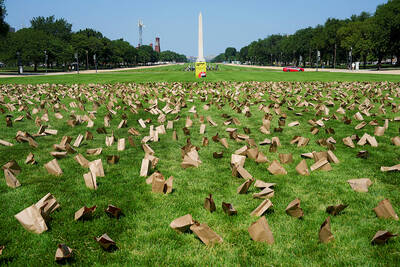HSBC Global Asset Management Taiwan Ltd (匯豐中華投信) yesterday launched the nation’s first low-carbon fund, which invests in bonds issued by companies with lower carbon footprints, to satisfy local investors’ increasing appetite for responsible investment.
The asset management firm gauges companies’ carbon footprints by measuring their carbon intensity, which divides companies’ carbon emissions by their revenue, using data offered by third-party agencies such as S&P Trucost Ltd, chief investment officer Julian Lin (林經堯) told a news conference in Taipei.
“Although some customers might expect a low-carbon fund to invest only in green energy companies, that is not practical, as there are not enough corporate bonds issued by green energy firms and we need to diversify our portfolio by investing in companies in different industries,” Lin said.
The offshore fund, dubbed the “HSBC Global Investment Funds — Global Lower Carbon Bond,” generally prefers companies with low carbon intensities, such as financing or green energy firms, but it would not be interested in firms whose carbon intensities rank within the first decile in the same industries, Lin said.
“For example, while most financing firms emit little carbon dioxide when making money, we dropped an Irish leasing company as it owns jets and provides leasing services to airlines, which emit carbon dioxide,” he said.
Meanwhile, companies with higher carbon footprints could still be investment targets in if their footprints rank in the bottom 75th percentile, as there is a chance that they would improve their carbon footprint in the coming years, Lin said.
“Overall, we target companies with lower carbon emissions among all industries, as we believe that they can better tackle challenges from climate change and tighter supervisions from regulators worldwide,” he said.
The average carbon intensity of all firms the fund invests in stands at 91.16 tonnes of carbon dioxide equivalent per US$1 million, 40 percent lower compared with the intensity of all firms in which HSBC’s global corporate bond fund invests.
HSBC Global Asset Management Taiwan would consider launching a locally domiciled fund linked to environmental, social and corporate governance (ESG) objectives, depending on the popularity of the low-carbon fund, chairman Steve Lee (李選進) said.
“We have noticed that local investors have a bigger appetite for ESG investment this year,” he said.
“Although it is still unclear whether companies with good ESG performance are more profitable than others, it is clear that they usually have better risk management and higher risk awareness. So, they could weather volatility such as the COVID-19 pandemic better than [others], which might be the reason they are gaining popularity,” he said.
Including HSBC, a total of 11 asset management firms have launched or applied to the regulator to launch new funds linked to ESG objectives, indicating an increasing appetite among local investors, according to data compiled by the Securities Investment Trust and Consulting Association.

Nvidia Corp chief executive officer Jensen Huang (黃仁勳) on Monday introduced the company’s latest supercomputer platform, featuring six new chips made by Taiwan Semiconductor Manufacturing Co (TSMC, 台積電), saying that it is now “in full production.” “If Vera Rubin is going to be in time for this year, it must be in production by now, and so, today I can tell you that Vera Rubin is in full production,” Huang said during his keynote speech at CES in Las Vegas. The rollout of six concurrent chips for Vera Rubin — the company’s next-generation artificial intelligence (AI) computing platform — marks a strategic

Enhanced tax credits that have helped reduce the cost of health insurance for the vast majority of US Affordable Care Act enrollees expired on Jan.1, cementing higher health costs for millions of Americans at the start of the new year. Democrats forced a 43-day US government shutdown over the issue. Moderate Republicans called for a solution to save their political aspirations this year. US President Donald Trump floated a way out, only to back off after conservative backlash. In the end, no one’s efforts were enough to save the subsidies before their expiration date. A US House of Representatives vote

REVENUE PERFORMANCE: Cloud and network products, and electronic components saw strong increases, while smart consumer electronics and computing products fell Hon Hai Precision Industry Co (鴻海精密) yesterday posted 26.51 percent quarterly growth in revenue for last quarter to NT$2.6 trillion (US$82.44 billion), the strongest on record for the period and above expectations, but the company forecast a slight revenue dip this quarter due to seasonal factors. On an annual basis, revenue last quarter grew 22.07 percent, the company said. Analysts on average estimated about NT$2.4 trillion increase. Hon Hai, which assembles servers for Nvidia Corp and iPhones for Apple Inc, is expanding its capacity in the US, adding artificial intelligence (AI) server production in Wisconsin and Texas, where it operates established campuses. This

US President Donald Trump on Friday blocked US photonics firm HieFo Corp’s US$3 million acquisition of assets in New Jersey-based aerospace and defense specialist Emcore Corp, citing national security and China-related concerns. In an order released by the White House, Trump said HieFo was “controlled by a citizen of the People’s Republic of China” and that its 2024 acquisition of Emcore’s businesses led the US president to believe that it might “take action that threatens to impair the national security of the United States.” The order did not name the person or detail Trump’s concerns. “The Transaction is hereby prohibited,”